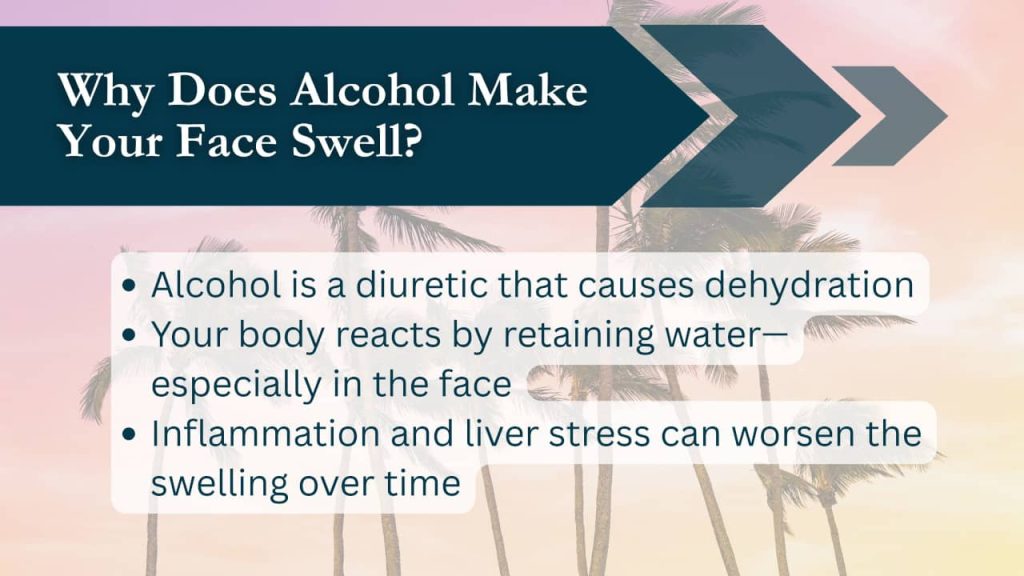Alcohol affects far more than your liver—it shows up in your skin, your eyes, and even the shape of your face. The term “alcoholic face” has circulated in pop culture and online searches, but what does it really mean? Is it a reliable indicator of problem drinking, or is it a misunderstood concept that unfairly stigmatizes people?
In this guide, we’ll explore what “alcoholic face” really refers to, the biological mechanisms behind facial changes from alcohol use, and what can—and can’t—be seen from someone’s appearance. We’ll also share how The Ohana rehab in Hawaii helps individuals restore health, dignity, and vitality at every stage of recovery.
What Does “Alcoholic Face” Mean and Common Myths
“Alcoholic Face” vs. Diagnosable Alcohol Use Disorder
The phrase “alcoholic face” is an informal term often used to describe visible facial signs that may appear with long-term, heavy alcohol use. These can include puffiness, redness, broken capillaries, or skin tone changes. However, it’s important to clarify that there is no official medical diagnosis called “alcoholic face.”
Alcohol Use Disorder (AUD), by contrast, is a clinical condition diagnosed based on behaviors, dependence, and psychological impact—not appearance. Many people with severe alcohol dependence may have no visible facial signs, while others may show symptoms due to unrelated health factors. The bottom line? You can’t diagnose alcoholism by looking at someone’s face.
Signs Are Clues, Not Proof: When to Avoid Snap Judgments
While alcohol-related facial changes can offer clues about someone’s health, they’re not definitive evidence of addiction. Dehydration, allergies, medication side effects, aging, or genetics can all mimic these signs. It’s also important to avoid stigmatizing people based on their appearance.
Instead, use these visible shifts as potential red flags—not confirmations. Concerned about a loved one’s drinking? Look at patterns, behavior, and overall wellness—not just their face.
Facial Signs of Alcoholism
While not everyone who drinks heavily will show obvious facial changes, some of the following may be associated with chronic or excessive alcohol use:
Puffy or Bloated Face (Fluid Retention and Inflammation)
Alcohol disrupts your body’s water balance and can cause the face to appear swollen or bloated—especially after a night of drinking. This bloating is caused by inflammation and fluid retention, both of which are common side effects of alcohol. You may notice puffiness around the eyes, cheeks, or jawline.
Facial Redness and Frequent Flushing (Vasodilation, Acetaldehyde)
Does alcohol make your face red? Yes—especially for people with a sensitivity to acetaldehyde, a byproduct of alcohol metabolism. Alcohol dilates blood vessels, leading to flushing of the cheeks and nose. Over time, repeated dilation can cause permanent redness or even skin damage.
Spider Veins on Nose and Cheeks (Telangiectasia)
Thin, red lines on the nose or cheeks—sometimes called “alcoholic nose” or “drinker’s nose”—are small dilated blood vessels known as telangiectasias. Chronic drinking can damage the vascular system and make these broken capillaries more visible, especially in fair-skinned individuals.
Dark Under-Eye Circles and Tired Look (Sleep Disruption, Dehydration)
Alcohol interferes with sleep quality and increases water loss. The result? Dehydrated skin, fluid imbalances, and poor circulation under the eyes. These factors combine to cause dark circles and a fatigued appearance.
Yellowish Skin or Eyes When Severe (Jaundice From Liver Disease)
In advanced cases of alcohol-related liver damage, jaundice can develop. This yellowing of the skin or whites of the eyes signals that the liver is no longer processing toxins efficiently—a medical emergency that requires immediate attention.
Premature Aging: Fine Lines, Sagging, Dullness
Alcohol depletes skin-supporting nutrients like vitamin A and collagen. Over time, this accelerates signs of aging—causing dull skin, deepening wrinkles, sagging, and loss of elasticity. The face may appear older than one’s actual age, even in younger individuals who drink heavily.

Alcoholic Face Before-and-After Photos: What They Show and Where They Mislead
You’ve probably seen viral “faces of alcoholism” photos, showing dramatic changes in appearance over time. While some of these are authentic, they can also be misleading or exaggerated.
Lighting, Dehydration, and Time Frames
Poor lighting, weight changes, and dehydration from a recent binge can make before-and-after photos look more dramatic than they are. Facial swelling from alcohol often fluctuates, and a single snapshot may not tell the whole story.
Reversible vs. Harder-to-Reverse Changes
Some changes—like puffiness, dullness, and redness—can begin to reverse within weeks of sobriety. Others, such as visible veins or liver-related jaundice, may take longer or require medical support. Skin has an incredible ability to heal, especially when alcohol is removed from the equation and replaced with good nutrition and sleep.
Why Does Alcohol Make Your Face Puffy?
Puffiness after drinking isn’t just about too many salty snacks. Alcohol triggers inflammation, disrupts the lymphatic system, and causes fluid to collect in tissues—especially in the face. It also weakens blood vessels, making them more permeable, which contributes to that swollen look. The body becomes less efficient at clearing toxins, resulting in bloating and a “heavy” appearance.

Female Faces and Alcohol: Patterns That Differ
Alcohol doesn’t affect all bodies the same way. Women often experience faster and more visible changes, due to differences in metabolism, hormones, and skin structure.
Faster Blood Alcohol Rise and Skin Barrier Differences
Women tend to have lower levels of alcohol-metabolizing enzymes and a higher percentage of body fat—meaning alcohol stays in their systems longer. This prolonged exposure increases damage to tissues, including the skin. Additionally, women’s skin is thinner and has fewer oil glands, which can make dehydration and irritation more obvious.
Hormonal Cycles and Fluid Retention
Hormonal fluctuations throughout the menstrual cycle already influence water retention. Alcohol compounds this effect, causing more noticeable puffiness in the days before menstruation. Some women find that even moderate drinking worsens facial swelling or dullness at specific points in their cycle.
How to Feel Better in the Short Term After Drinking
If you wake up with a bloated or flushed face after drinking, there are a few simple things you can do to feel and look a bit more refreshed—though these are temporary fixes, not long-term solutions.
- Apply a cold compress or jade roller to reduce swelling and inflammation.
The cold helps constrict blood vessels, which can reduce redness and puffiness in the face. A jade roller or chilled spoon rolled gently over the skin can also promote lymphatic drainage and reduce facial bloat. - Use a hydrating face mask or moisturizer with hyaluronic acid to soothe dryness.
Alcohol dehydrates your skin, leaving it tight, dull, or flaky. Replenishing with a rich moisturizer or sheet mask that includes ingredients like hyaluronic acid or aloe vera can restore a healthy glow and ease discomfort. - Sip water with electrolytes to help flush retained fluid.
Rehydration is key after drinking. Electrolyte-enhanced water helps your body rebalance faster, reduce water retention, and ease the pressure that contributes to facial puffiness.
Avoid more alcohol, salt, or caffeine, which can prolong puffiness.
These substances all worsen dehydration or inflammation. Giving your body a break from irritants helps it recover faster and reduces facial swelling more effectively.

These strategies may offer some quick relief, but they won’t reverse the deeper effects of alcohol use. For lasting improvement—especially if you notice facial changes regularly—reducing alcohol intake or seeking support may be necessary. The Ohana offers holistic recovery options that help clients restore both health and appearance from the inside out.
Longer-Term Reversal: What Improves and on What Timeline
The good news: many alcohol-related facial changes can improve or reverse with sustained recovery.
- Within a few days: Puffiness, dullness, and dryness often begin to improve as hydration and sleep normalize.
- After a few weeks: Blood flow and skin tone even out. Redness and inflammation decrease.
- After several months: Collagen production rebounds, eyes look brighter, and wrinkles may soften.
- Long-term: Liver function and hormone regulation stabilize, allowing the body to support healthy skin aging.
At The Ohana, we’ve seen remarkable transformations in clients’ appearance and confidence as they recover. Healing from alcohol is more than skin deep—but feeling better about how you look can be a powerful motivator.
When to Take Action and How to Raise Concern
If you notice persistent changes in a loved one’s appearance—such as bloating, redness, or skin discoloration—it may be time to talk. But focus the conversation on health and behavior, not looks.
Try:
“I’ve noticed you’ve seemed more tired and your face looks a little flushed lately. How have you been feeling?”
Or:
“I’ve been reading about how alcohol can impact sleep and skin. I’m wondering if it’s affecting you, too.”
Approach with empathy. Facial signs of alcoholism can be reversed—but only when the person is ready and supported to make a change.
The Ohana Hawaii: Healing That Goes Beyond the Surface
At The Ohana Hawaii, we know that healing isn’t just about stopping drinking—it’s about rebuilding the body, mind, and spirit. Our holistic addiction recovery programs support every aspect of wellness, including:
- Nutrition counseling to reduce inflammation and nourish the skin.
- Acupuncture and massage to boost circulation and lymphatic drainage.
- Mindfulness and trauma therapy to address the emotional roots of addiction.
- Clinical care that treats the whole person, not just their symptoms.
Whether you’re just starting to question your drinking or you’re ready to make a full change, The Ohana offers a compassionate, medically sound, and deeply restorative environment for recovery.

Alcohol-related facial changes can range from subtle to severe—but they’re just one piece of a much larger picture. If you’re noticing signs in yourself or someone you love, it may be time to reach out.
Help is available. Hope is real. And healing is always possible.
Ready to begin? Call us to learn more about our programs in Hawaii.













